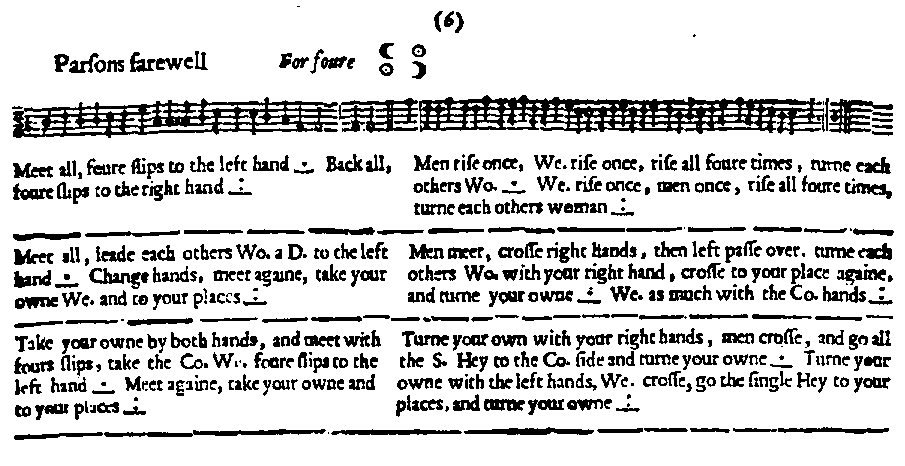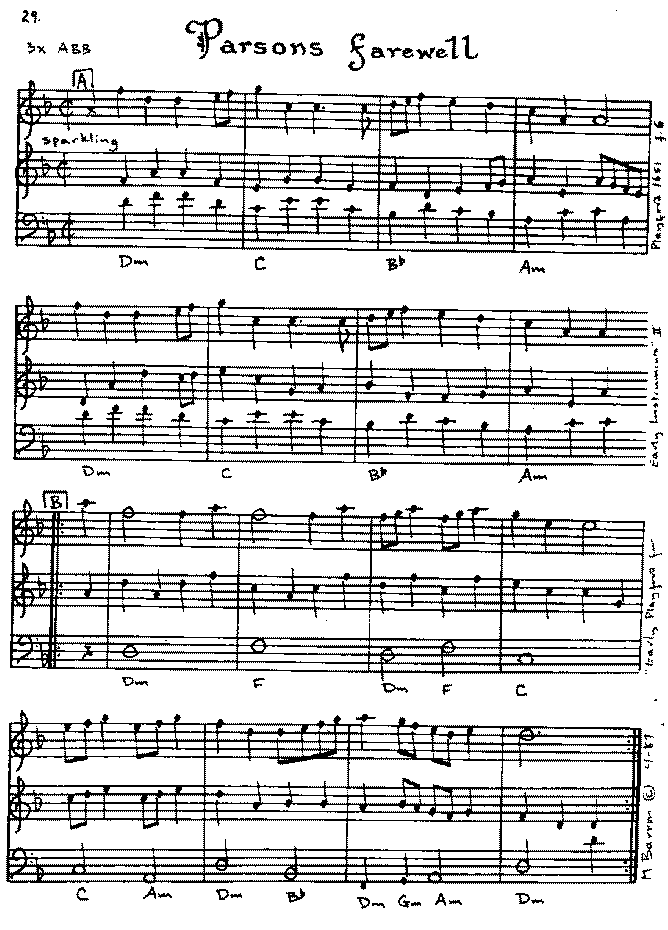Parson's Farewell
by Dani of the Seven Wells
[ This article appeared in
volume 1 of
the Letter of Dance. ]
[Editor's Note: this article is copiously annotated -- follow the
links to the footnotes.]
Parson's Farewell is an advanced Playford dance for sets of two
couples. Its difficulty does not lie so much in the complexity of the
steps (though there is a fair amount to remember) as in the
unforgiving nature of the figures, particularly the final one: If
dancers hesitate, or lag behind the music, it is very difficult to
recover. (This is not typical of Playford's dances.) The dance
requires more teaching and practice than is the norm, but once it has
been properly learned it ceases to be difficult. At which point it is
simply fun.
My annotated copy of English Dancing Master (edited by Margaret
Dean-Smith) has the following comment about the title:
"The term `farewell' had a particular meaning in the 16th and 17th
centuries equivalent to `goodnight,' i.e. verses written by the
condemned before execution; it may also be analogous to the
`going-out' song or dance in numerous masques and stage-plays. In
verse it is commonly used with personal names."
The instructions for this dance are presented below, in three parts.
First, the original Playford instructions are given, along with an
arrangement of the music. Below that, the instructions are repeated
in what I hope is a more usable format. Those instructions should be
all that is needed for anyone who has ever done the dance. Finally,
extensive footnotes on the reconstruction are provided for those
unfamiliar with the dance, or for anyone wishing more information
about the decisions which were made in reconstructing it.
I. Original Instructions, and Music
The material in figure 1 is taken directly from The Dancing Master, by
John Playford, published in London, 1650/1.
[1]

The music in figure 2 was arranged by Marshall Barron, in her book
Early Playford for Early Instruments, Volume 2.

II. Reconstructed Instructions
Parson's Farewell -- Playford, 1651
sets of two couples, facing. [2]
2/2 time. [3]
- chorus 1:
- 1-2 forward a double [4],
[5]
- 3-4 each couple double to own left
- 5-6 back a double
- 7-8 each couple double to own right[6]
- rising:
- 9 Men nod to each other (going up on their toes)
[7]
- 10 Ladies nod
- 11-12 Everyone nod across, diagonally, to partner
[8]
- 13-16 Turn corner once around
- 17-24 (9-16) but with the ladies nodding before the men
[10]
- chorus 2:
- 25-26 forward a double
- 27-28 Take corner's hand, and [quarter turn and] double away from
partner [11]
- 29-30 Half-turn around in place and double forward to meet partner
[12]
- 31-32 Take partner's hand and double back to place
[13]
- turning:
- 33-34 Men take left hands and switch places
[14]
- 35-36 Take opposite's right hand and turn once around
- 37-38 Men take left hands and switch back
- 39-40 Take partner's right hand and turn once around
[15]
- 41-48 (33-40) but done by the women, all reversed. (Women take
right hands and switch places; take opposite's left hand, etc.)
[16]
- chorus 3:
- 49-50 Face partner and slide a double to meet the other couple
- 51-52 Face opposite and slide a double away from partner
- 53-54 Slide back towards partner
- 55-56 Take partner's hand and double back to place
[17],
[18]
- heys:
- 57-58 Men turn partner once around by right hand
[19]
- 59-60 Men change places passing right shoulders
[20]
- 61 Men change places with partner, still passing right shoulders
[21]
- 62 Men change places with opposite, passing left shoulders
[22]
- 63-64 Take partners' hands and half turn.
[23]
- 65-66 Women turn partner once around by left hand.
[24]
- 67-68 Women change places passing left shoulders
[25]
- 69 Women change places with partner, still passing left shoulders
[26]
- 70 Women change places with opposite, passing right shoulders
[27]
- 71-72 Take partners' hands and half turn back to original positions.


